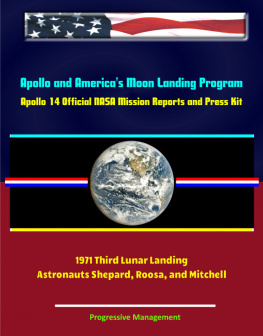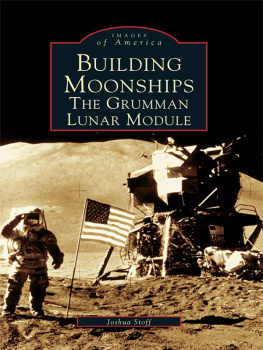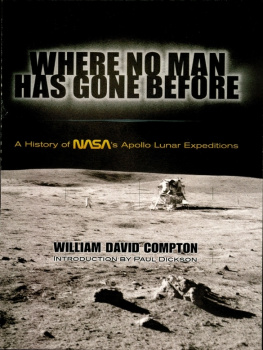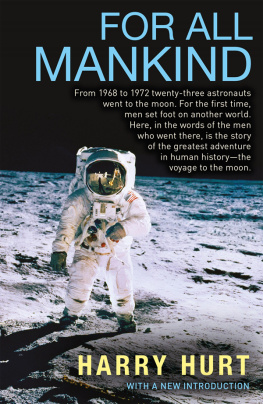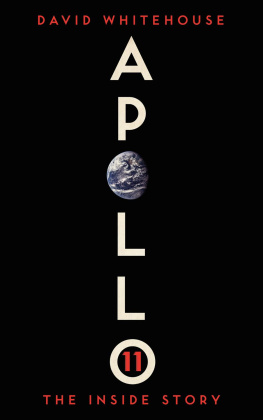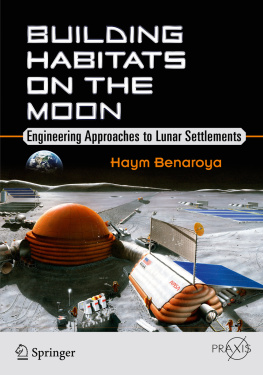Natalie Spinetti had sufficient patience and provided encouragement throughout the composition process.
Thanks goes to Sue Strelow for her inputs and her diligent efforts in checking spelling and punctuation.
Jerry Parker helped explain and correct the problems with the *@^ computer word processing along the way.
Table of Figures
(Figure 1) Apollo PGA 20
(Figure 2) PGA/ITMG 21
(Figure 3) Apollo 11 Lunar Module 22
(Figure 4) Early spacesuits 24
(Figure 5) Apollo Saturn V 25
(Figure 6) North Brookfield Farm 26
(Figure 7) Apple Tree 34
(Figure 8) Dad and Parker Kids 38
(Figure 9) Wool Carding Machine 41
(Figure 10) Salem Cross Inn 44
(Figure 11) Pouring Steel 48
(Figure 12) Railroad Construction 50
(Figure 13) Loading Dock 53
(Figure 14) Navy Fire Proximity Suit 60
(Figure 15) Friden Calculator 77
(Figure 16) Feed Port on Helmet 81
(Figure 17) Leonardo Sketch 82
(Figure 18) Mercury Capsule 90
(Figure 19) Sputnik 102
(Figure 20) View from Hubble Telescope 104
(Figure 21) Helmet Head Cushion 114
(Figure 22) Suit Interconnects 119
(Figure 23) Velcro 122
(Figure 24) Footprint on the moon 124
(Figure 25) Apollo 11 Crew Armstrong, Collins and Aldrin 125
(Figure 26) Red Arm Bands in EVA 126
(Figure 27) ITMG glove 127
(Figure 28) Detroit Lions Silverdome 145
(Figure 29) Solar power 147
(Figure 30) Space Shuttle 150
(Figure 31) Curtain Wall Architecture 152
Preface
In a writers workshop, I submitted a short essay on my aerospace contributions in helping to put men on our moon and have them returned safely to Planet Earth. I was surprised by the amount of interest generated, as the other members of the group were considerably younger.
It hadnt occurred to me that many of them werent around for the first lunar landing by the Apollo 11 Mission crew. I was floored when they pointed out that for them, this was history. When I stopped to think about it, in 2019 it will be 50 years since men first walked on the moon in July of 1969. It almost seems like it was only yesterday. It is really astonishing that there still are people who claimed the trips into space and to the moon were all faked on a movie set somewhere.
One mother of a five-year-old boy was anxious to learn about how I became an aerospace engineer/rocket scientist. Apparently, she was extremely interactive with her son and worked with him constantly to make sure he had all the age appropriate toys and games that he could learn from and be challenged by them. Although I tried to be as helpful as I could, it felt like she wanted to clone a younger version of me with her son.
This memoir explains how to become an aerospace engineer or rocket scientist at a time when classes and information to accomplish either didnt exist. The examples contained herein are intended to demonstrate how someone can tackle any new problem or challenge, even when it is outside their comfort zone or area of expertise. With creative thinking, use of ones entire background and experience enables technology transfers between fields of application to adapt square pegs to fit in round holes (or how to get to the moon and back).
Starting off in chemical engineering, I did more engineering, materials development and processing than chemistry early in my career. Many problems and product development approaches were resolved by working with suppliers to determine how to use their products. Discussions with customers or government agencies helped to find out what was needed for their applications.
My job descriptions in the space programmes evolved from the race to space with the Russians. They were beating us on every step into the cosmos. We were afraid that left unchecked, they could rain missiles and rockets down on us from Earth orbit or a base on the moon.
There was neither a blueprint on what we were trying to do nor instructions available on how to accomplish it. Basically, I had to use everything I had learned on the farm, in school and all my part-time jobs to figure out how to help the astronauts get from point E (Earth) to point M (moon) and back unscathed. Because it was unchartered territory, every step of the way was a challenge, a lot of fun and a very rewarding experience.
So where does one go when the space programme slows down due to lack of funding? Besides the fulfilment of reacting to the challenges of programmes, demands and solving problems, one wants to assure that ones family is well provided for.
When sales, marketing and product managers were being paid more than technical people, I switched to doing that instead. As a business and product line manager, I usually didnt have sufficient technical support, so I ended up performing that function as well. Eventually, I became a general manager and president of a small company. I was good at handling the business aspects, but it wasnt fun, just paperwork. I ended up as technical director in product line management as well as doing research and development where I could be more creative again.
For the most part, in my day schools didnt teach students how to think. School primarily consisted of memorising things that were too soon forgotten. I had a science teacher named George Dahlquist in high school who would say, The man who said it couldnt be done was rudely awakened one morning by the sound of someone doing it.


